The Ultimate Guide to Reading Like a True Nerd
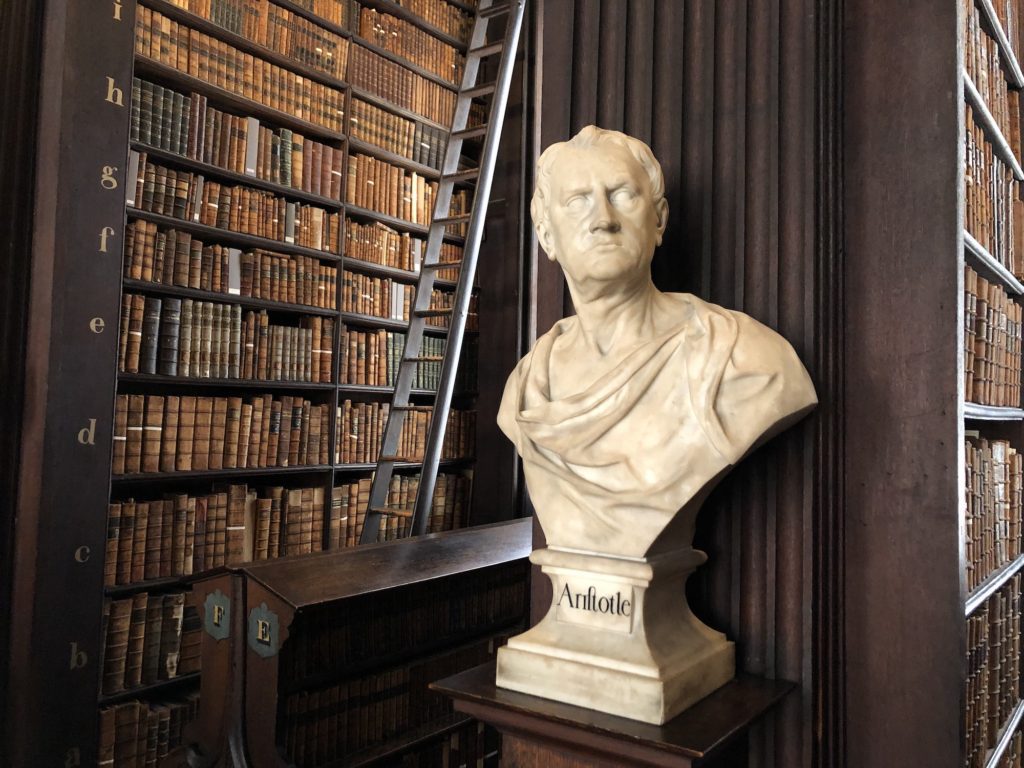
I've read over 700 books in the past ten years. If that doesn't grant me nerd status, I don't know what would.
Books are a really big deal in my life, and one of my greatest joys is helping others develop a deeper passion for reading. What I've found is that many people aspire to read more, but they fall short of their own goals for one reason or another: too busy, not a priority, unsure what to read, don't get much from what they read, etc.
My goal with this article is to help you overcome those objections. If you're hoping to read more and soak up more knowledge from what you read, this article is for you.
Here's what you'll find in this ultimate guide to bookishness:
How To Pick Great Books to Read
With all of the millions of books out there, how do you know where to start? It can definitely be overwhelming to choose, but thankfully there are some great sources out there to help you increase your "hit rate" of finding the right books.
The most reliable (and underrated) recommendation source I've found is books that are referenced within other books that I love. Almost every nonfiction book contains a heap of book recommendations, and many fiction books reference other books too.
For example, I noticed that several of my favorite books all recommended the book Mindset by Carol Dweck. So I picked up Mindset, and it was awesome. Same thing with Steal Like an Artist by Austin Kleon. I hadn't heard of that book until it came up in numerous other books I read, so I went straight to the source and read Kleon's work (all of it, in fact). His stuff is amazing, which wasn't a surprise because I already knew he had influenced several other authors I admired.
Just like everyone else, I also pick up book recommendations in conversations with friends. But I've noticed that everyone has a different threshold for which books are worthy of recommending. Some people hesitate to share recommendations because they think their literary taste is unique and others won't enjoy the same books. Others throw out recommendations willy-nilly, eagerly recommending anything they've ever read, rather than only referring the absolute best books.
Because recommendations are inherently subjective, I've started to use a little system to sort through the wheat from the chaff. I generally make the time to check out a book if any of the following things happen:
- Multiple people recommend the same book
- Someone talks about how a specific book tangibly impacted their life
- Someone who I know reads a LOT of books says that a certain book was the best book about ______ that they've read recently
If someone shares a recommendation that doesn't rise to the level of any of the things on the list above, I make a quick mental note about that book and go about my day. Life is too short to read books that aren't amazing, and we all only have a limited amount of time to read, so it's important for all of us to relentlessly prioritize what we choose to read.
Lastly, I spend a lot of time in bookstores, thumbing through books on the shelves. This is one of the trickiest ways to find book selections because you're heavily dependent upon the bookstore's curation and which books they decide to feature in prominent locations that catch your eye. But I've still found that it's helpful to scan the aisles and stumble upon new books.
If I find a random book in a bookstore that sounds interesting and I haven't heard anything about it, I usually rely on a few shorthand methods of determining if the book will be worth the time:
- I read the synopsis and sometimes the first page of the book. Often, you can tell whether you like a writer's writing style remarkably fast. If you don't want to keep reading after the first page, set the book down.
- I check out the list of recommendations that are generally on the back cover of the book. If one of my favorite authors has recommended the book, that's a pretty good sign.
- I flip through the book. Many of my favorite nonfiction books have pleasant formatting. The authors not only know how to express their ideas with words, but also with images, graphs, and blockquotes. Sometimes you can get a good read off a book just by how much care the author put into the formatting and presentation of their ideas.
“Of course you can judge a book by its cover — that’s why books have covers. They’re designed to catch people’s attention and draw them toward the work — and away from all the other works that stand equal on the shelf.” -Ryan Holiday
But again, the best way to find books is to read the ones referenced by the authors that you already love. The people who influenced them are probably worth reading!
How to Read More
When people find out how much I read, they immediately assume I'm a speed reader. I'm not. I read about as fast as the next person. I just spend a massive amount of time reading.
On average, I read a couple of hours every night. This means that I spend much less time on social media, television, and news than most people.
Why do I spend so much time reading? Because I believe in this quote:
“What you will become in five years will be determined by what you read and who you associate with.” -Charles 'Tremendous' Jones
In five years, you won't remember the Instagram photos you liked, the memes you re-tweeted, or the TikTok videos that made you laugh. But you will remember the books that influenced your life. The memoirs that helped you empathize with someone else's struggle. The novels that taught you why forgiveness is better than revenge. The biographies that inspired you to dust yourself off after a bad breakup, layoff, or betrayal.
Once you personally experience the potential in books to change your life, you'll want to find more time to read as well. The best way to read more is also the simplest way: make more time for it. Cut out other things in your life. Prioritize reading over other tasks that don't move the needle.
Specifically, I've used these seven tactics to read more:
1. Set reading goals
Goals have a way of orienting our brains to know that a given task is really important. Setting a goal also has the mysterious power of marshaling more forces to your aid.
“At the moment of commitment, the entire universe conspires to assist you.” -Goethe
For almost a decade, my personal goal has been to read 70 books each year. That breaks down to about six books each month, or two every 10 days.
If I’m 20 days into a month and I’ve only read two books (instead of four), I know I’m behind my goal. When that happens, I try to carve out a little more time to read.
Your goal will be different than mine. Perhaps it’s five books per year…or 100. You set your own pace.
For example, one of my friends told me partway through 2019 that he had already read four books — which was more than he had read in all of 2018. That was a huge win. He was elated, and I was elated for him. The important part is setting the right goal that works for you.
2. Set aside solo time every day
I think solo time is really important. In fact, I even go on solo retreats twice a year to get away from the busyness of life and get to know myself a bit better.
Almost everyone I've talked to agrees that carving out solo time is difficult, but possible. Life doesn't make space for us to do important things, so we need to relentlessly seek out time to do what's important to us.
Do your darndest to find some quiet time amidst your crazy schedule. For you, that may be early in the morning before your kids are awake, or during lunch at work, or right after you get home. For me, it's every night between 9:30-11:30pm after my wife goes to bed. Evenings are my time to read, write, journal, and think.
Find the time that works for you, then jealously protect that time. Make it a priority.
3. Read multiple books at the same time
Many people believe that you should read the same book from start to finish before starting the next book. I vehemently disagree.
I've found that I read WAY more books when I have two or three books going at the same time. At any given time, I'm usually reading one fiction book, one nonfiction book, and one spiritual book. I do this because it helps me have a book for any mood.
For example, I was reading a business book last week, but then I didn't feel like reading about business anymore. So I picked up a novel and enjoyed that for a bit. If I had only been reading one book at a time, I would have dropped the business book and jumped into a different (and probably lesser) form of entertainment: social media, TV, etc.
Reading multiple books at a time is like stocking your pantry with a host of healthy snacks rather than a bunch of junk food. If an apple doesn't sound good, and all you have in your pantry are apples and Oreos, you're going to find yourself neck-deep in the Double-Stuffs. But if you have apples, bananas, and trail mix on hand, you may opt for healthier fare instead, even if you don't feel like an apple.
By keeping a few books going at one time, you’ll have books for each of your moods and preferences throughout the course of a given week.
4. Don’t give in to the social pressure of grabbing your phone or watching TV
“Reading takes time, and the glass teat takes too much of it. Once weaned from the ephemeral craving for TV, most people will find they enjoy the time they spend reading. I’d like to suggest turning off that endlessly quacking box is apt to improve the quality of your life…” -Stephen King
For some reason, it seems like it’s more socially acceptable for people to whip out their phones than to pull out a book. For example, I’ve noticed that when my wife and I are hanging out with family during the holidays, people tend to turn on the television or surf the web on their phone once the conversation starts to lull at the end of the night.
I feel like a weirdo for grabbing my book, but I’ve decided that I’d rather be a productive weirdo than an unproductive lemming.
If you want to do something on your phone, that’s totally fine, but don’t give in to the social impulse to jump onto a device just because everyone else is doing it. Have the courage to pick up a book. You'll get done a lot more reading and waste a lot less time.
5. Build an anti-library
Author Nassim Nicholas Taleb talks about the importance of building an “anti-library” — a collection of books that you haven’t read.
“Collect books, even if you don’t plan on reading them right away. Nothing is more important than an unread library.” -Austin Kleon
My personal library is packed with countless books I haven’t read. Every time I look at my bookshelves, I’m reminded that I need to get my butt in gear because there are so many books I want to read.
Sometimes when I’m looking for reading inspiration, I walk into my library to gaze at all of the wisdom I want to soak up. Then I grab the next book and dive in.
6. Visit bookstores more often
Similar to the idea of building an anti-library, I visit bookstores to further ignite my reading passion. Sure, walking into a bookstore doesn’t equate to actual reading time, but it definitely offers inspiration and motivation.
Every time I visit a local bookstore, I leave with a sense that I need to prioritize reading even higher because there’s so much out there to learn.
7. Bring a book with you everywhere
If I know I’ll need to wait somewhere later in the day (getting a license at the DMV, bringing my car in for an oil change, etc.), I bring a book.
Those random minutes add up, and you want to take advantage of them. By thinking ahead, you can ensure those little pockets of time don’t go to waste.
“You can do so much in ten minutes’ time. Ten minutes, once gone, are gone for good. Divide your time into ten-minute units and sacrifice as few of them as possible in meaningless activity.” -Ingvar Kamprad

How to Save Money on Books
Sometimes people tell me they’re surprised I could spend so much money on books. What they don’t realize is that it doesn’t actually cost much to have an epic reading appetite. In addition to free avenues like the library, there are dozens of cheap places to buy books.
“The literature available at your average library amounts to millions of pages and thousands of years of knowledge, insight, and experience.” -Ryan Holiday and Stephen Hanselman
For years, I used to visit thrift stores to find inexpensive books: Goodwill, Savers, Value Village, you name it. Every decent thrift store has a books section, and each book generally costs somewhere in the range of $0.50 to $4.00. I’ve walked out with armfuls of reading material more times than I can count.
Then I stumbled upon the website ThriftBooks.com, which is an online thrift store that contains thousands of used titles — many of which are priced at $3.99. The site also offers free shipping if you buy $10 worth of books.
Rather than spending hours visiting thrift stores, I can type a few words into a search bar and track down almost any book I want for super cheap. (Brand new books sell for the standard price, but it's a great place to search for books that are at least a few years old.)
For someone who reads a lot, that website is a total game-changer. I've told all of my friends about it too, so now all of us buy most of our books on there. I have saved hundreds (if not thousands) of dollars on books by shopping on ThriftBooks.
By finding inexpensive places to quench your reading habit, you can ensure that cost never stands in your way.

How to Remember What You Read
My memory isn't great, so for the past decade, I've been experimenting with various tactics to remember takeaways from the books I read.
I've found a handful of specific tips that have greatly increased my reading comprehension. I think they’ll help you too.
1. Read physical books instead of e-books
I remember my excitement a few years ago when I arrived home from Barnes & Noble with my new Nook Color e-reader. I was sure that device would transform my reading experience.
It did, but not in the way I assumed.
One of the first books I read on my e-reader was The Maze Runner by James Dashner. After finishing the book, I raved about Dashner’s writing to a few friends. One of them had also read The Maze Runner, so we talked about the book’s chilling conclusion.
Er, I mean my friend talked about the conclusion. I couldn’t remember it. Embarrassingly, I had forgotten how the book ended.
The same thing happened to me a few other times with my e-reader. I began to feel like an idiot. My memory had never failed me like that with books before.
I turned to the all-knowing internet for answers. As it turns out, early studies suggest that people using e-readers absorb less information, get distracted by multitasking, and don’t enjoy the experience as much as those who read physical books.
“Whether they realize it or not, many people approach computers and tablets with a state of mind less conducive to learning than the one they bring to paper.” -Ferris Jabr
Although some studies have disagreed with those findings, my personal experience convinced me I should only read physical books.
2. Talk about lessons learned
Often the best way to learn something is to teach it. I’ve found that I internalize lessons from books much better once I’ve had the chance to discuss them with others.
“In learning you will teach, and in teaching you will learn.” -Phil Collins
My first explanation of any book is often unpolished. As the words come out of my mouth, I realize I have failed to fully digest the author’s main points. However, by the second or third time I’ve discussed a book, I’ve crystallized my own understanding of the lessons and I’m finally able to articulate them.
3. Create a “commonplace book”
A commonplace book is a place to compile knowledge for future reference. While many people use a physical book for this practice, any cataloging system can serve the same purpose.
Many people throughout history have used commonplace books, including Thomas Jefferson, Marcus Aurelius, Francis Bacon, E.M. Forster, H.P. Lovecraft, and Bill Gates.
My commonplace book (pictured below) is adapted from one used by bestselling author Ryan Holiday, who adapted his from Robert Greene.
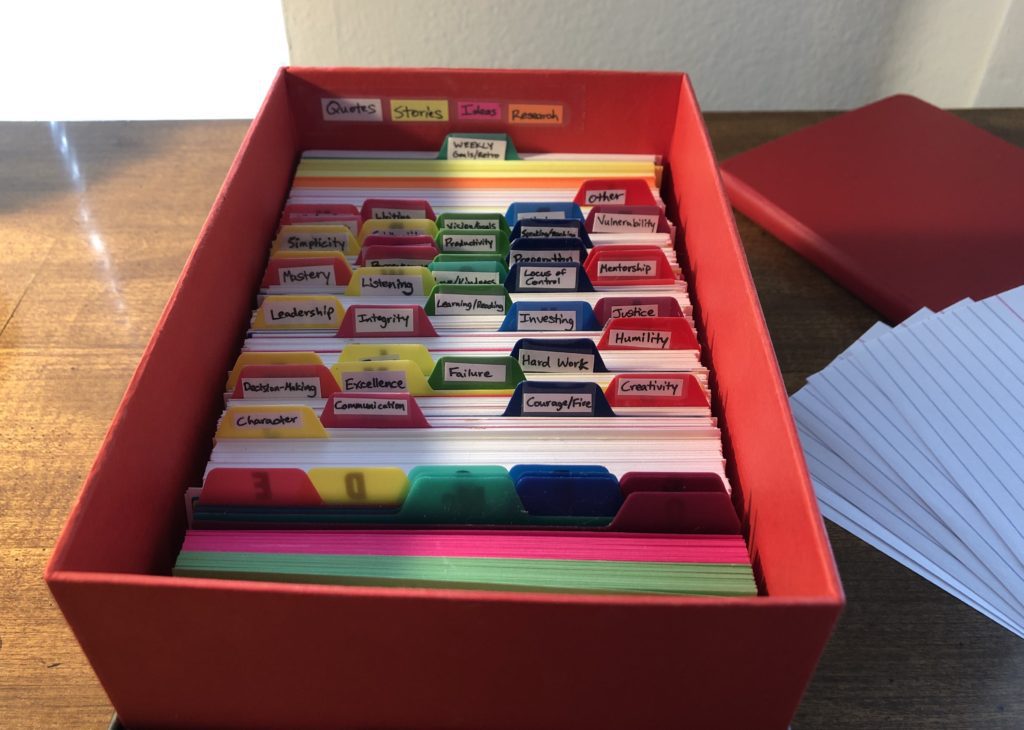
For my commonplace book, I write quotes, stories, ideas, and research data on 3x5 cards. I label each card with a topic (e.g., Leadership, Productivity, Decision-Making), then sort the cards by topic.
The entire setup cost me about $20. I bought a few packages of 3x5 cards and two batches of index card dividers, then turned an old headphones box into my storage container.
By taking the time to jot down these notes, I'm able to not only remember more of what I read, but I can also quickly track down exact quotes and data for later stories that I write. If you're interested, I share more details about commonplacing in this post.
4. Refuse to borrow books
When friends discover my love of reading, they instantly offer heartfelt recommendations of books I should borrow from them.
My answer is always no.
Refusing to borrow books narrows my focus to only those books that are good enough to buy. Every book I buy is an investment in my development and a chance to build my personal library.
But more importantly, I refuse to borrow books because I can’t write in borrowed books. I can’t make them my own. Purchasing my own books gives me the freedom to take margin notes, as explained in detail below.
5. Take margin notes
I used to view books as hallowed ground. I wouldn’t consider writing in them any more than I’d consider putting a million bumper stickers on my car. (What are you people thinking?)
But then I realized that what made a book special was not its words, but what those words sparked inside me: ideas, inspiration, and action. So I began writing notes in the margins of my books. Lots and lots of notes.
My “marginalia” puts me in control of what I will learn from the book and how it will impact my life after I turn the final page. Writing notes in a book enables me to engage in a form of co-creation with the author. His or her work inspires me to brainstorm insights pertinent to my own life and immediately consider how I can put those ideas into practice.
“In getting my books, I have always been solicitous of an ample margin; this is not so much through any love of the thing in itself, however agreeable, as for the facility it affords me of penciling in suggested thoughts, agreements, and differences of opinion, or brief critical comments in general.” -Edgar Allen Poe
Not only do my margin notes act as a cheat sheet for later reference, but the very act of writing handwritten notes helps me remember what I've read. Studies have routinely shown that writing notes by hand boosts memory more than typing notes on a computer.
Because margin notes are such an important aspect of remembering key takeaways from your reading, I've devoted the entire next section of this post to discussing marginalia in detail.
Note: While digital notes don’t aid comprehension the same way handwritten notes do, they still offer a unique benefit of searchability. If you're a digital notes person, you may find it helpful to jot down book notes in an app like Evernote or Day One.
How to Take Amazing Margin Notes
I used to treat my own books no differently than a library book. It felt wrong to deflower the pages with my scribbles and underlines, so each margin remained milky white. Then I realized that what made a book special was not its words, but what those words sparked inside me: ideas, inspiration, and action.
Writing notes in a book enables you to engage in a form of co-creation with the author. Marginalia helps you transition from idea to inspiration to action. It helps you remember what you’ve learned from any book and apply it to your life after you turn the final page.
With how much I read, it’s important for me to remember what I’ve learned and put those lessons into practice, so I’ve been developing my own system of advanced marginalia.
The core of the system is extremely simple, but I’ll share pictures along the way to show how you can maximize each step.
Here are the three steps of my “SUB” system (Star, Underline, Back Cover):
- STAR key passages to quickly find them later
- UNDERLINE essential quotes and ideas on each page
- Use the BACK COVER of the book to record your biggest takeaways
1. Star key passages to quickly find them later
As I’m reading a book, I place an asterisk (*) next to key passages to help me track down those ideas later when I riffle through the book.
For passages that seem really important, I circle the asterisk so I can find the material even faster. The circled asterisks are generally the items that I jot down in the back cover of the book (explained in step #3 below).
Here’s an example of a typical page of one of my books. You’ll notice a couple of stars and margin notes that will help me find those ideas quickly later.

2. Underline essential quotes and ideas on each page
As I read, I ask myself the question: “If I was to go back and skim-read this book, what few sentences on this page would I need to read to understand the core concept or the essential elements of the plot?” The answer to that question determines what parts I underline.
Underlining or highlighting is not an exact science. Different ideas and quotes resonate with different people. Sometimes my wife reads a book that I’ve read and marked up, and she’s surprised by the types of things I underlined. They don’t make sense to her, and they’re not really supposed to. Your notes are for you — not for anyone else.
While I read, I also take note of new words I don’t know. For example, the picture above is from the book Stein on Writing by Sol Stein. Page 116 of that book contained the word “antediluvian,” which I had never heard before, so I looked it up and jotted the definition on the bottom of the page. I’ve been using a backward pilcrow (the paragraph symbol) to designate new vocab words, but you can use any symbol you’d like.
3. Use the back cover of the book to record your biggest takeaways
This is the most important part of my marginalia system. Years ago, I realized that if I wanted to thumb back through an old book to find a quote or concept, I had to scan through every page to find what I wanted.
That seemed ridiculous, and I knew there must be a better way to summarize what I had learned and where I could find it in the book, so I began using the inside back cover of every book to record my primary takeaways.
Here’s an example from Walter Isaacson’s biography Benjamin Franklin:
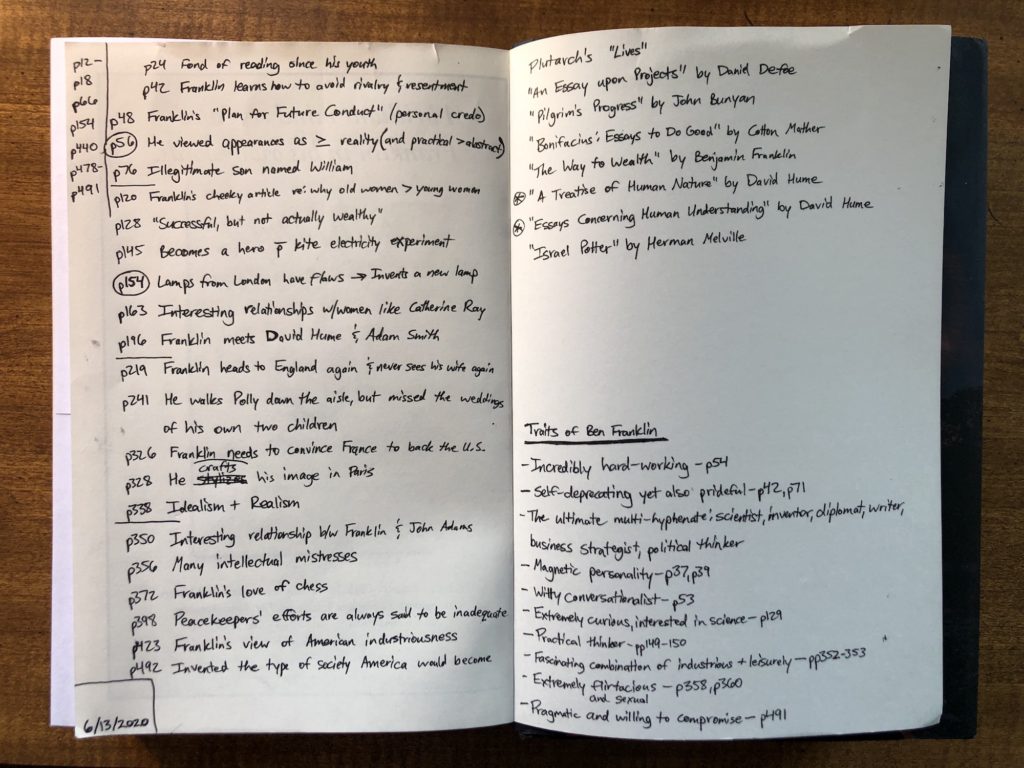
If you look closely, you’ll notice several different types of notes in the image above. Here’s a description of those notes from left to right:
- Favorite Quotes — The upper left corner includes page numbers of a few of the author’s best quotes.
- Key Takeaways — The main section on the left page includes a page number alongside each core insight from the book. I usually end up with about 15–25 main takeaways from every book.
- Date Finished — The bottom left corner shows the date I finished reading the book. If and when I re-read a book, I’ll write the re-read date as well.
- Book Recommendations — Most authors are insatiable readers. Many writers consume 10–50 books while researching a book, and they generally reference those books throughout the text, along with sprinkling in some of their other favorite books. I write the author’s recommendations in the upper right corner of the back cover. If I want to dive deeper into some topic from the book, those recommendations give me a great starting point.
- Personality/Character Traits — In the bottom right corner, I jotted down a few things I learned about Benjamin Franklin as a person: what made him successful, what he struggled with, etc. I’ve begun to write lists like this in biographies, and it’s fascinating to see the common character traits between successful people in diverse fields (curiosity, work ethic, etc.).
The types of things I write in the back cover of a book differ based upon the type of book I’m reading. For example, the last bullet point above about Personality/Character Traits wouldn’t make sense in a book about economics, psychology, or leadership. For those types of books, I jot down other notes, like what I plan to apply from that book to my life.
Here's an example of my back cover notes for the marketing and communication book Made to Stick by Chip and Dan Heath:
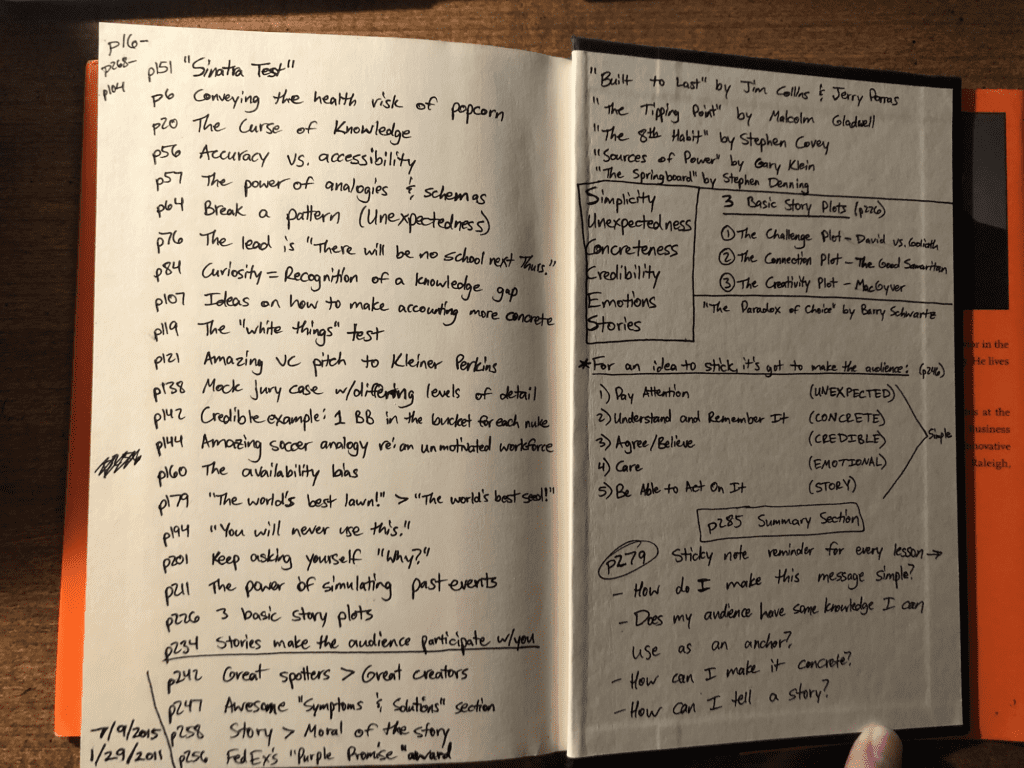
I also write notes in fiction books. I’ve found that the notes help me follow along with the plot and remember what happened in the story. I also usually write a character list on one of the pages of the book’s back cover.
For example, here are my back cover notes from Les Miserables by Victor Hugo:
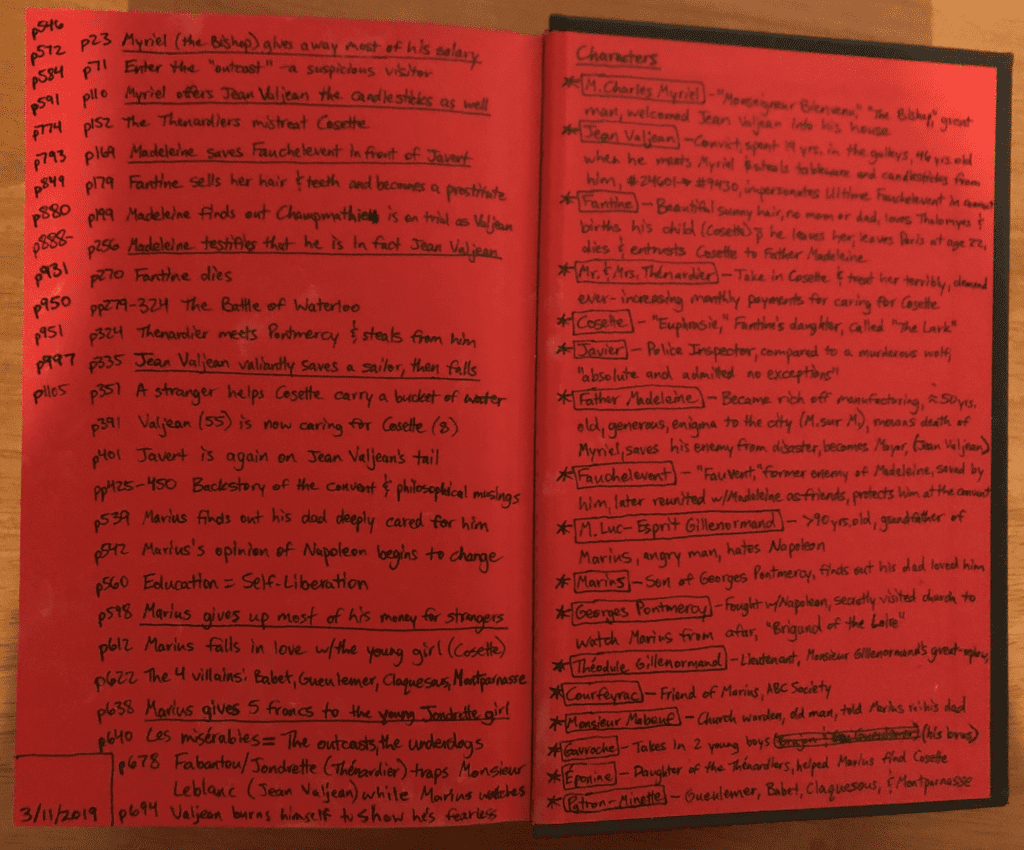
Depending upon the type of book, I’ve also begun to write timelines in the back of some books. I primarily do this in history books, biographies, memoirs, and even some business books.
Here’s a picture of my timeline from the Benjamin Franklin biography:

Step up your reading game by using the SUB system (Star, Underline, Back Cover) of advanced marginalia:
- Star key passages to quickly find them later
- Underline essential quotes and ideas on each page
- Use the back cover to record your biggest takeaways
It’s a simple system that you can use in powerful ways.
How to Keep Track of What You've Read
“My alma mater was books, a good library…I could spend the rest of my life reading, just satisfying my curiosity.” — Malcolm X
I highly recommend tracking the books you've read. It not only helps jog your memory of past books, but it's fun to look back at the types of books that influenced your thinking each year.
I've been tracking my reading list for the past 12 years. I started by writing the list in a physical notebook, then later moved it over to Goodreads and the Recent Reads page on my blog. I take a lot of pride in that list, and it motivates me to keep pushing — to continue learning more and more.
Plus, it’s fulfilling to look back upon the literary ground you’ve covered. If you haven’t done so yet, start keeping a journal or online document of the books you’ve read.
If you've never used Goodreads before, I suggest starting there. They even have a yearly challenge where you can input your reading goal and they'll track your progress throughout the course of the year. (Example below.)
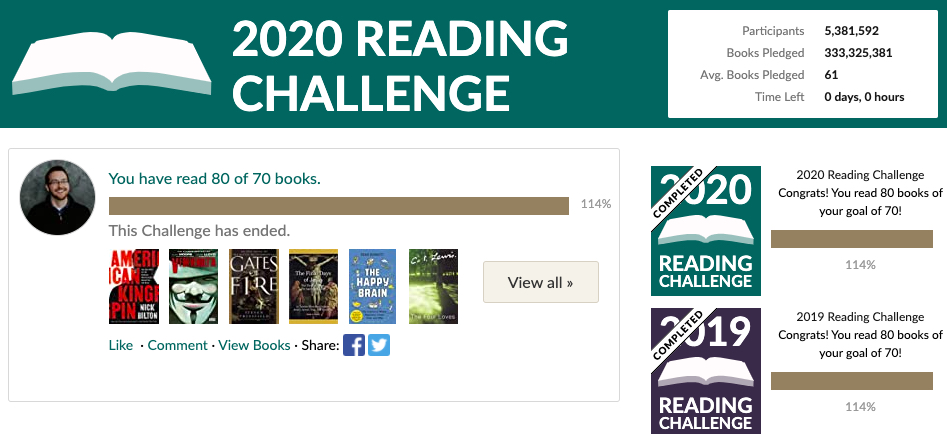
Reading great books is one of the best ways to develop yourself as a person. Every minute you spend reading is a minute that you've invested in your future.
My hope is that you can use the tips above to reach whatever goals you have for reading and personal development. Feel free to leave your own bookish insights below. I always love hearing what tactics have worked for others.
Happy reading!
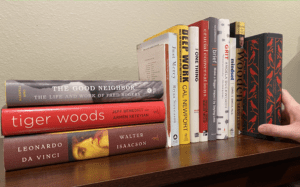
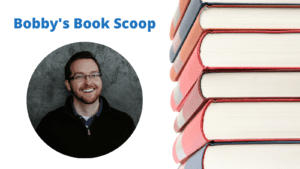


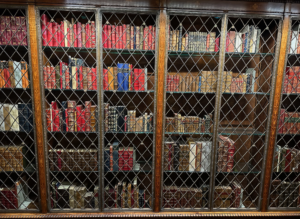

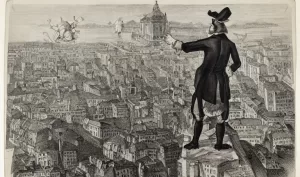
When I was in graduate school to become a high school librarian I learned about professional organizations that write book reviews, like Kirkus Reviews, Publisher’s Weekly, School Library Journal. All of these publications give starred reviews to the books they deem to be the best. I started paying attention to these starred reviews as I was building my collection for the library. One cannot read every book before purchasing them for a library so it was a tool that helped me feel like the books I was purchasing had met some standards for excellence. The more starred reviews, the better. The highest number a book could earn in children’s publishing was six, so I would strive to purchase those with 4+ starred reviews, if I could.
As I started paying attention to starred reviews I noticed the correlation to book awards. In the YA world, The Michael Printz Award went to the best YA books published in the US in a given year. The American Library Association gives out all kinds of awards each year. The ALA Youth Media Awards for 2021 were just announced last Monday. I would look over the prize winners that were also YA books to help make my purchasing decisions. I would automatically purchase the Printz winners if I didn’t already have them in the library.
At some point I had enough prize winners in the library to allow check-outs to all the students of several English teacher’s classes at once and I kept a really elaborate database for them to consult to make their decisions. At this point I branched into adult book awards that might interest advanced readers. The National Book Award, Pulitzer Prize for literature, Carnegie Medal, Booker Prize, Andre Norton, Bram Stoker, RITA, etc. The National Book Award does give out one award to Children/teens each year so I would certainly scrutinize their long list and the finalists. Now that I am retired I still look at these lists and try to read the winners, at least. In fact, I have set myself a personal reading challenge to read all current Pulitzer Prize winners and many past winners, going back to its inception. With few exceptions I have found these books as excellent as one would expect from a winner of such a prestigious award. (Here is a list of my reading challenges which includes my Pulitzer Project.)
I know you like to own your own books so you can write in them. I rarely buy books for myself (though my junky bookshelf would make you think differently.) Instead, I am a big fan of libraries because the books are free! In pre-COVID days I liked to wander around libraries and I would always end up at the displays where librarians set aside their favorite books. Sometimes they will include little blurbs about what they like about the books. I take these to heart. Like bookstores (My town no longer has any bookstores. None.) I can wander around a library and end up with some real treasures that I wasn’t expecting to find, often off topic from whatever I was searching for in the first place.
Around the time I started book blogging, I decided I needed help keeping track of the books I read and have used Goodreads as my tool. I don’t use Goodreads for book suggestions, however. I use it as a place for me to keep track of my books. My short reviews there help me quickly look back on what I was thinking when I read it. This has become a very valuable tool to keep me on track. My end-of-the-year survey, which you now do also, is made possible because of the tags I add to each book. Since one can create their own tags on the site, I just make tags that will be useful in the future for finding books around a theme. Mine are things like: audiobooks, poetry, children’s, Pulitzer, re-reads, did not finish, YA, etc. In addition to noting books I’ve read, I also keep a list of books “I want to read” or TBR books. If someone I trust, like you, recommends a book, I add it to this list. Several times a year I will review the growing TBR pile of books to determine if I still want to read it or not. If the answer is the latter, it is easy to delete the book and forget about it. But the ones on the ‘want to read’ list that remain serve as a reminder of what I could read next. The day before the COVID restrictions went into place, I had dropped by the library and checked out twelve books from my TBR list. Lucky for me, too, since the library shut down for over a month before they opened up with curb-side check outs. My current TBR list has over 200 titles on it and it includes books for my Pulitzer challenge, current books, and old classics I’d still like to read.
Lastly I talk to people about books. If I like and trust the persons judgment I often find myself adding the books they mention to my reading list. Sometimes I add the books to my list because the recommender is a sister or a nephew, like you, and I want to have that book in common with them. For one of my book clubs we select the books ourselves and we go through a rather detailed vetting process before making our selections. One gal does not have a very good track record for making good recommendations so when she suggests a title, I am biased against it. Ha! But I bet others could say the same thing about me. Many of the books I like aren’t liked by the others. I think that is because I often listen to the audiobook version and have a more positive experience with the book than they did.
As a book blogger I have many virtual ‘friends’ that also blog about books whom I have come to regard very highly over the years. Four gals in all areas of the country (California, Texas, Delaware, and Maine) write especially good book reviews and have tremendous sway on my choices. If Helen or Deb say they like a book, I add it to my TBR. If they say they don’t like it, forget it. The book won’t see the light of day on my reading list.
Now that my answer is almost as long as your original blogpost, I’ve decided to grab it and post it on my blog. I’ll link your original post and your questions. Let’s see if my blogging friends have any other suggestions to facilitate further discussion.
Anne, I love that you turned this into a post on your site as well! That’s great. Thank you for your thoughtful responses, and I enjoyed reading what you wrote about your reading experiences. 🙂
Not enough words to describe how valuable this post is. Due to some health issues which left me with some minor cognitive impairment, I’ve had a hard time remembering what I’ve read. The idea of writing key info in the back of the book is a life altering (enhancing?) revelation for me. Especially when it comes to the characters in a book—which for someone with my disability can be extremely hard to keep straight. Thank you!!
My question is do you write things in the back of the book as you go along or at the end as a distillation of the important things you want to recall? I can see jotting down the characters and timeline as you go along, but what about key points in a non-fiction book?
Katy, you have given me such a gift with your thoughtful, kind comment. Thank you for taking the time to share that story with me, and I am so glad that this post was helpful for you!
I write in the back cover as I go rather than after finishing the book (for both fiction and nonfiction). That way, I don’t need to remember what to write later; I just write all of the takeaways in the moment. Generally, I end up with 15-25 key takeaways in the back of the book, but it definitely depends on the book. It’s a personal judgment call for which takeaways are important enough to go in the back. For me, it comes down to which insights are most surprising, personally applicable, or potentially even life-changing…the key things I want to be sure I remember from the book.
I hope that’s helpful, and please let me know if you have any other questions! 🙂